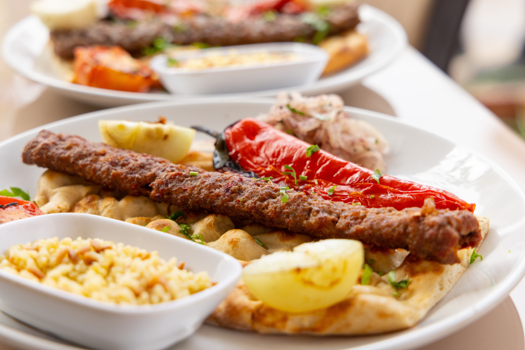Take a culinary journey through Turkey, and you’ll discover a richness in culture that spills over into the food. With a history that is centuries old, Turkish cuisine has absorbed different cultures, and its distinct flavors have been shaped by geography, climate, and proximity to the sea. From hearty stews to decadent desserts, Turkish cuisine is a feast for the senses.
Why is Turkey a Foodie’s Destination?
Turkey, a land where history and flavors harmonize in a magical way, invites us to discover its culinary treasures. From the bustling streets of Istanbul to the tranquil shores of the Mediterranean and the heartland of Anatolia, Turkey’s diverse regions offer an array of dishes that are as varied as its landscapes.
Let’s Get to Know Turkish Cuisine
Delicious Dishes
A Turkish culinary journey often begins with kebabs. These tender, grilled morsels of meat or vegetables, seasoned with a symphony of spices, are an iconic Turkish dish. Whether you’re savoring a juicy Adana kebab or a fragrant chicken shish kebab, you’re in for a treat.
But Turkey doesn’t stop at savory dishes. Enter Baklava, a sweet pastry that oozes with honey and crushed nuts. Each bite is like a sweet symphony, a perfect balance of crisp layers and gooey sweetness.
And don’t forget Turkish delight, those chewy, colorful confections that come in various flavors like rose, pistachio, and pomegranate. They are not just candies but a glimpse into the country’s sweet traditions.
Ingredients
The secret to any cuisine’s deliciousness lies in its ingredients. Turkish chefs generously employ a variety of spices, such as cumin, paprika, and sumac, to create vibrant and flavorful dishes. Herbs like mint, parsley, and dill also add a refreshing touch to many recipes.
Meats, such as lamb and beef, are often used in Turkish cooking, and they’re prepared with precision and care to ensure tenderness and taste. Vegetables like eggplant, peppers, and tomatoes play a crucial role, especially in Mediterranean cuisine.
Culture and Food
Eating Habits
Turkish food isn’t just about what’s on your plate; it’s also about how you enjoy it. Turkish meals are a communal affair, where family and friends gather around a table to share food, stories, and laughter. It’s a celebration of togetherness.
One cannot talk about Turkish food without mentioning tea. Turkish tea culture is a cherished tradition. Sipping strong black tea from tiny glasses, often accompanied by a sugar cube, is a ritual deeply ingrained in Turkish people’s daily lives.
Food Traditions
Turkey’s rich cultural heritage is intertwined with its food traditions. During the fasting season, or the Holy Month of Ramadan, the streets come alive with the aromas of mouthwatering dishes being prepared for the evening ‘Iftar’ meal. It’s a time of reflection, gratitude, and breaking fast together with loved ones.
And then there’s Turkish coffee, a strong, aromatic brew that’s not just a beverage but also a symbol of hospitality. The ritual of brewing and serving Turkish coffee is a gesture of warmth and welcome.
Hospitality is at the core of Turkish culture. When you visit a Turkish home, you’re likely to be greeted with a warm smile and a generous spread of food. The concept of ‘Meyhane,’ a traditional Turkish tavern, epitomizes this spirit of hospitality. Here, friends gather, share stories, and enjoy a variety of mezes (appetizers) alongside Raki, the national anise-flavored spirit.
Regional Flavors
Turkey‘s vast expanse boasts a diverse culinary landscape, with each region offering a unique palette of flavors and specialties that reflect its geographical and cultural influences. As we traverse the country, we encounter distinct regional tastes that captivate our senses.
Istanbul: Where East Meets West
Istanbul is the cultural bridge between East and West. Tourists may sample local specialties at one of the many bustling marketplaces, like the Grand Bazaar. Here, the streets are alive with the enticing aromas of spices, sweets, and street food. You can savor a medley of dishes influenced by Ottoman and Mediterranean cuisines, making Istanbul a gastronomic melting pot.
Enjoy a worry-free food trip to Turkey in 2023 with the help of Exoticca. This trusted travel company presents an array of enticing vacation packages to the “Land of the Crescent Moon,” with delightful stops in Istanbul. Go on an epic gastronomic adventure without the hassle of handling typical tourist logistics like flights and accommodations. Your only concern? Deciding what delectable dish to savor next and whether there’s room for another bite.
Mediterranean Coast: A Seafood Paradise
Heading south to the Mediterranean coast, you’ll find a seafood lover’s haven. The crystal-clear waters provide a bountiful harvest of fish and seafood, which form the basis of many coastal dishes. Grilled octopus, stuffed mussels, and succulent sea bass are just a few of the coastal treasures. The liberal use of olive oil, fragrant herbs, and fresh vegetables creates a symphony of flavors that perfectly complements the sea’s bounty.
Anatolia: Heartland of Hearty Dishes
Venturing into the heartland of Anatolia, we uncover a treasure trove of hearty dishes that have sustained generations. One such delight is Borek, a flaky pastry filled with an assortment of ingredients, ranging from cheese and spinach to minced meat. Its versatility and comforting flavors make it a beloved staple across Anatolian kitchens.
In the city of Bursa, we encounter the mouthwatering Iskender kebab, a local specialty that has gained nationwide acclaim. Thinly sliced doner meat, tender and flavorful, is generously laid over pieces of pita bread, then lavishly adorned with a sumptuous blend of tomato sauce and yogurt. Bursa’s Iskender kebab is a testament to the city’s culinary prowess.
Gaziantep: Baklava Capital
Gaziantep, a city located in southeastern Turkey near the border with Syria, is revered as the baklava capital of Turkey, and for good reason. Here, Baklava is elevated to an art form. The meticulous preparation, using premium ingredients, particularly prized pistachios, results in a baklava that is unparalleled in its flavor and texture. Gaziantep Baklava is a sweet masterpiece that tempts dessert connoisseurs from far and wide.
Turkish Cuisine: A Celebration of Life
A culinary journey through Turkey will take you on a rollercoaster of flavors and cultural revelations. From the irresistible kebabs of Istanbul to the sweet delights of Gaziantep, Turkish cuisine is something your taste buds and hearts will never forget.
But it’s not just about the food; the people, the traditions, and the warmth also make dining in Turkey an unforgettable experience. The act of breaking bread together transcends borders and languages, and in Turkey, it’s a true celebration of life.
So, the next time you find yourself in Turkey, remember to savour not just the dishes but also the culture, the hospitality, and the joy of sharing a meal with newfound friends. Because in Turkey, every meal is a journey, and every bite is a story waiting to be told.
– sponsored –















